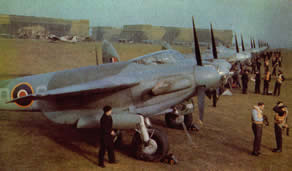A.P.Rowe and his Sunday Soviets
- Pathfinder Squadrons
The accuracy of bombing achieved by the RAF during 1940 and
1941 was considered totally unacceptable. There had been a
terrible loss of men and machines and very few successes.
Professor Lindemann had produced a report (the Butt report)
in August 1941, which estimated that less than 10% of the
bombs dropped were reaching their targets. Some 31,500 tons
of bombs had been dropped in the first six months of 1941.
| |
| The raid on Berlin by 169 bombers on 7th November
1941 proved a total failure and the raids in the
spring of 1942 on Germany's industrial centers proved
equally ineffectual. However, in November 1941 Group
Captain S.O. Bufton was appointed Deputy Director
of bombing operations. He was an experienced officer
and he suggested that what was required was a specific
Target Finding Force. The Commander in Chief was
Air Chief Marshal Sir Arthur Harris and he vehemently
opposed any suggestion of setting up an 'elite'
force within the RAF. He advocated that each Group
should develop its own specialist squadrons. In
August 1942, Air Marshal Portal overruled Harris
and then Group Captain D. Bennett, a young Australian,
was appointed to command the new TFF, which comprised
just 4 squadrons and was renamed as the Pathfinder
Force. |
|
|
|
| |
|
The first raid using the new
force was on 18th August 1942 but it was not a success.
This was due to the rudimentary navigational aids installed
in most bombers at that time and to the limited training
the crew had received. Group Captain Bennett lost no time
in ensuring that his new force was properly equipped,
firstly with GEE which had been used operationally since
the massive Cologne raid of 30th May 1942. The next system
to be commissioned was OBOE (from 21st December 1942)
and finally in early 1943, H2S was introduced.
The first Mosquito mission equipped with Oboe flew from
RAF Wyton on 20th December 1942 and the first H2S Pathfinder
mission was a raid on Hamburg on 30th January 1943.. |
| |
|
| The mosquitoes were particularly suited
to this type of work because they could fly
fast and low and then accurately drop flares
onto the targets for the following bomber
squadrons. The bombing accuracy improved 7-fold
once the new squadrons were fully trained
during 1943.
By 1945 No 8 Group had grown to 19 squadrons,
II with Mosquitoes and 8 with Lancasters.
|
|
|
|
|
Mosquitoes
of 139 (Pathfinder) Squadron at dispersal
1943
|
|
 |
|
|
|
| |
|
|